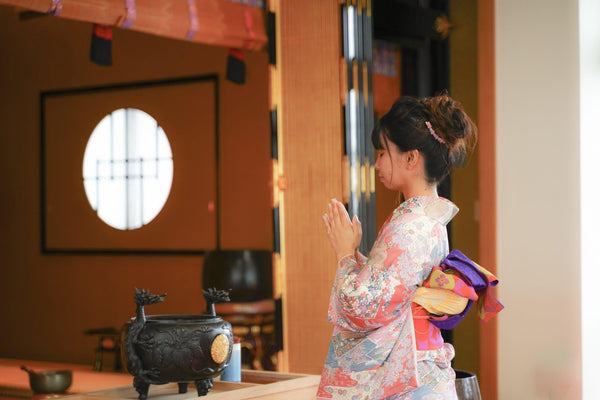
Jump to:
New Year's (Shogatsu or Oshogatsu, お正月) is considered the most important holiday in Japan. The term "Oshogatsu" is a combination of two words: "o," which means honorific or respectful, and "shogatsu," meaning New Year. There are a lot of traditions and events that take place before and during the New Year’s season in Japan, so in this article, we’ll cover everything you need to know about this important holiday and how it is celebrated in Japan.
When Is Oshogatsu?
Japan primarily follows the Gregorian calendar, meaning that the New Year falls on the same day as it does in most other countries. Oshogatsu is typically celebrated from January 1st to January 3rd. However, the entire period from late December to early January is considered a holiday season in Japan. There are many customs, traditions, and even festivals that take place before the New Year is even rung in, which we’ll explain throughout this article.
Common Decorations For New Years
During the New Year's celebration in Japan, various traditional decorations are used to create a festive and auspicious atmosphere. These decorations are believed to bring good luck, prosperity, and ward off evil spirits. Many different decorations can be found in Japanese homes, and the decorations will of course vary depending on the family, but here are some common ones:
Kadomatsu

Kadomatsu is a traditional New Year's decoration placed at the entrance of homes, businesses, and temples. It consists of bamboo shoots, pine branches, and sometimes ume (plum) branches. Kadomatsu symbolizes longevity, prosperity, and the presence of the Shinto spirits.
Shimekazari
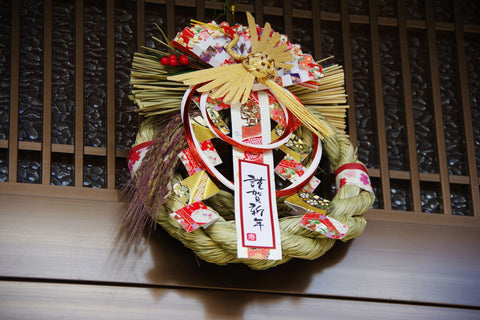
Shimekazari is a New Year's ornament hung on the entrance doors of homes. It typically includes sacred shimenawa (rice straw rope) with shide (zigzag-shaped paper), along with auspicious decorations like bitter oranges (daidai), ferns, and white ritual papers (gohei). Shimekazari is believed to ward off evil spirits and invite good fortune.
Shimenawa
Shimenawa is a sacred rope made of rice straw and adorned with shide paper zigzags. It is used in Shinto rituals and is often hung above entrances during the New Year to purify the space and keep away negative energies.
Kagami Mochi
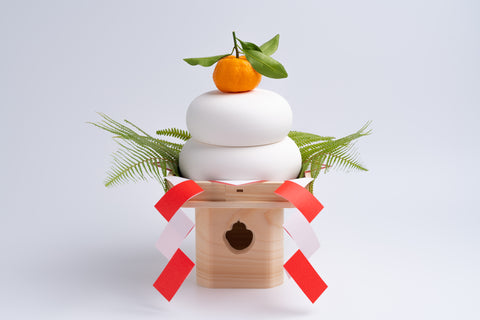
Kagami mochi is a traditional New Year's decoration consisting of two or more round rice cakes (mochi) stacked on top of each other with a bitter orange (daidai) on top. It symbolizes the spirit of family and is often displayed on a stand called a sanpo (three-tiered stand). This is a common Oshogatsu decoration that you can find being sold in even supermarkets and drug stores in December.
Popular Oshogatsu Traditions
Along with popular decorations that hold important meanings for Oshogatsu, there are also customs and traditions performed during December, particularly in the latter half, which hold significance in marking the end of the year.
Nengajō (New Year’s Cards)
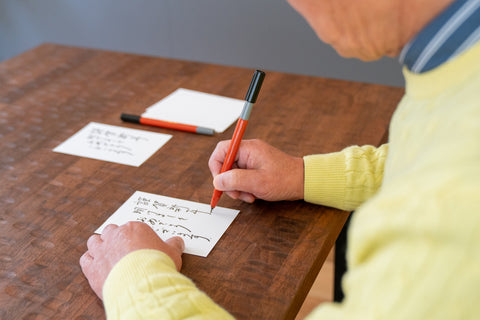
One of the most common practices done is writing Nengajō (年賀状), or New Year’s cards. It is a traditional custom in Japan where people send these cards to friends, family, and colleagues to convey good wishes and greetings for the upcoming year. Nengajō are usually sent in the weeks leading up to the New Year and are expected to be delivered on January 1st. While Nengajō are still commonly written on cards, sending electronic Nengajō via social media is becoming more popular with younger generations, as the same message can still be conveyed and it is less time intensive.
Osouji

Before ringing in the New Year, many Japanese practice ‘Osouji’ (大掃除) (literally translates to big cleaning) in their homes, schools, and even workplaces. The idea to thoroughly clean one’s surroundings is thought to bring a fresh and pure start to the New Year. It is seen as a way to sweep away the dust and clutter of the past year, both physically and metaphorically. That’s why when doing Osouji, it’s not just about performing normal cleaning tasks or cleaning visible surfaces, but also focusing on areas that are often overlooked. Osouji is more similar to deep cleaning, so people really take the time to clean every area in their home or workplace, and often get rid of clutter or anything needlessly taking up space. While many people do Osouji during the last few days of the year, it is absolutely important to complete it by December 31st.
Mochitsuki (Mochi Pounding)

"Mochitsuki" (餅つき) is a traditional Japanese event or activity that involves the pounding of glutinous rice to make mochi, which are rice cakes. The main ingredient for mochitsuki is glutinous rice, also known as "mochi rice" or "sweet rice." This type of rice has a high starch content, which gives mochi its distinctive chewy and sticky texture. This mochi is an especially important ingredient for Oshogatsu because it’s used in Ozoni (a soup which we’ll cover a little later in this article.)
Glutinous rice is soaked and then steamed until it becomes soft and sticky. The steamed rice is then transferred to a large usu (wooden mortar) and is pounded with a kine (wooden mallet). One person wields the mallet, while another person moistens the rice and turns it between each strike to ensure even consistency.
Mochi is not commonly made at home these days, as it is so easy to purchase commercially made mochi, but getting together as a community to do mochitsuki is a fun event for families and especially children to experience traditional Japanese culture.
New Year’s Food
Of course with New Year's being the most important holiday in Japan, there is a big emphasis on the food enjoyed during this holiday.
Osechi Ryori
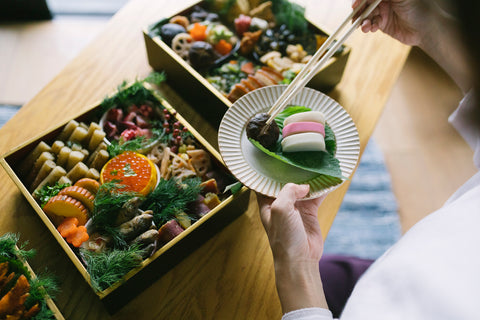
Osechi Ryori, translated to "New Year's dishes" refers to a collection of meticulously prepared, symbolic dishes served in tiered lacquer boxes during the New Year's celebration. Osechi Ryori is usually enjoyed around the 1st to 3rd of January in Japan when a lot of restaurants and businesses remain closed for the holidays.
Osechi dishes tend to be very colorful, and presentation is key. Putting this elaborate cuisine together takes families a few days of work to put everything together. Each Osechi Ryori dish is also thought to have its own meaning often related to prosperity, happiness, longevity, and good fortune. If you want to learn more about the elaborate cuisine, be sure to check out our Osechi Ryori article.
Ozoni
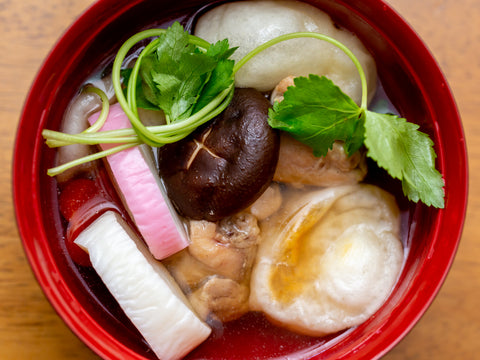
Served alongside Osechi Ryori is Ozoni. Ozoni is a clear dashi or miso-based soup that features mochi, along with other hearty ingredients such as carrots, daikon, and leafy green vegetables. Arguably, the most important ingredient in Ozoni is the toasted mochi. The mochi is toasted to give the exterior a crunch, keeping the interior nice and chewy. The style of Ozoni varies depending on the region (or the family, really), and the ingredients and shape of mochi can also differ. Enjoying Ozoni, along with Osechi, is thought to bring good luck into the new year. Want to learn how to make Ozoni at home? Check out our Kanto-style Ozoni recipe!
Toshikoshi Soba
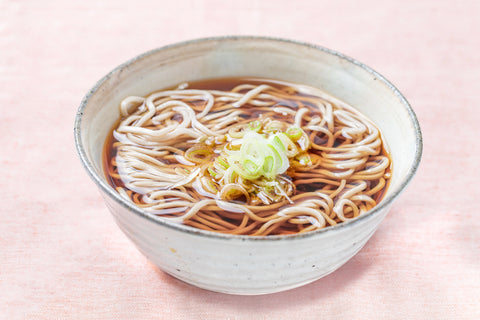
Another common practice done during the New Year is enjoying a bowl of Toshikoshi Soba. Toshikoshi soba consists of a bowl of soba noodle soup and is usually simply topped with green onions. Some people also opt to add other toppings such as fish cakes or even shrimp tempura, but this dish is mostly kept simple. Toshikoshi translates to year crossing and the long, thin soba noodles are thought to reflect a long life.
Countdown To Oshogatsu & The First Sunrise
Similar to other cultures, the Japanese also celebrate the countdown to midnight on New Year's Eve. Temples and shrines may ring bells 108 times throughout the day to symbolize the 108 earthly temptations. The ringing of these bells is thought to help people overcome their earthly desires and pave the way for a fresh, pure start to the New Year. Specifically, the bells are rung 107 times leading up to midnight on the 31st and once past midnight on the first.
Hatsumode, Omamori, & Omikuji
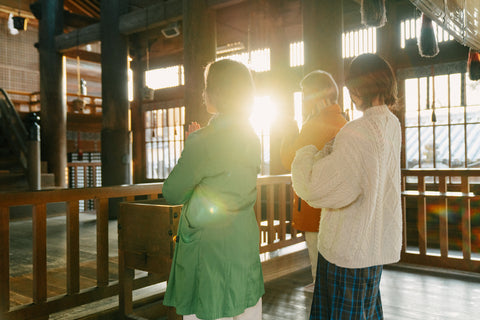
Watching the first sunrise of the year, known as "hatsu-hinode," is considered auspicious, and people often go to scenic spots to welcome the sunrise. Popular scenic spots include the mountains and coastal areas, but really any area with a good view of the sunrise is suitable for partaking in hatsu hinode.
Another popular custom to commemorate the New Year is partaking in Hatsumode. Many people visit Shinto shrines or Buddhist temples for the first visit of the year, known as "hatsumode." Many Japanese like to do Hatsumode within the first three days of the New Year, some even go the night of New Year’s Eve, but really any first visit to a shrine or temple in Japan is considered to be Hatsumode.
Purchasing a good luck charm (omamori), or fortune (omikuji), is commonly done during Hatsumode. Omamori are thought to provide various kinds of good luck and protection, which is especially important symbolism for the start of a New Year. There are specific omamori sold only during the New Year’s called Shogatsu Omamori. They often feature symbols associated with New Year celebrations, such as images of the zodiac animal for the upcoming year (according to the Chinese zodiac), good luck symbols, or traditional Japanese New Year motifs.
Omikuji fortunes are divided into different categories, ranging from extremely good (大吉, daikichi) to extremely bad (大凶, daikyou), with various levels of good and bad fortunes in between. Omikuji can be purchased at the main hall of temples and shrines. There is often a wooden box or container containing rolled-up strips of paper. After paying a small amount of money, sometimes around 100 yen, (or in some cases, just making a small offering), visitors shake a container or draw a stick from a box to select a random omikuji without looking at its content. Omikuji fortunes often include advice, predictions, and recommendations related to various aspects of life such as relationships, health, studies, and work. While omikuji can be purchased year-round, the omikuji purchased during Hatsumode is thought to hold a lot of importance in predicting how the year ahead will turn out.
Note: many shrines and temples offer omikuji, but not all of them do. It might be good to check beforehand if the shrine or temple you’re interested in going to offers omikuji.
Otoshidama
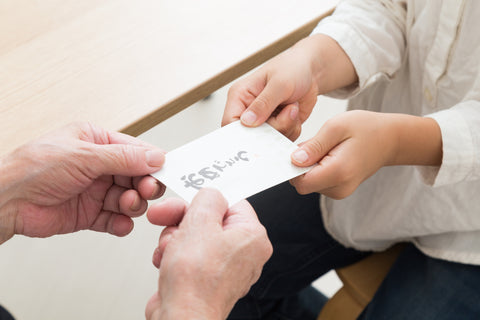
"Otoshidama" (お年玉) is another important New Year’s tradition in which money is given in small, decorative envelopes from adults to children. Otoshidama is a way for adults, particularly parents, grandparents, and other family members, to convey blessings and financial support to the younger generation as they start the new year.
The money is typically placed in special envelopes, specifically made for otoshidama, and often contain New Year's symbols, zodiac animals, or other Oshogatsu motifs. The most important part, of course, is that they represent good luck and fortune.
The amount of money given as otoshidama can vary based on the age and relationship with the recipient. It is common for grandparents to give larger amounts of money than aunts or uncles, for example. The money must also be presented as fresh, crisp bills.
Important Greetings & Phrases For Oshogatsu
The common New Year's greeting is "Akemashite Omedetou Gozaimasu, 明けましておめでとうございます" which roughly translates to "Happy New Year." This phrase is used after the new year has rung in.
"Kotoshi mo yoroshiku onegaishimasu 今年もよろしくお願いします" is another phrase used once the new year has come, expressing the hope for continued good relations in the new year.
Before the new year is officially here, people say “Yoi Otoshi Wo 良いお年を” which means “Have a nice year.” This phrase is used often during the last few days of the year, especially on December 31st.
Should I Visit Japan During Oshogatsu?

Well, we can’t entirely answer that question for you. What we can say, however, is that many businesses, shops, and restaurants are closed from January 1st to the 3rd. Some even close for the last few days of December.
Oshogatsu is also a peak time for travel, as many Japanese are traveling to their hometowns to spend time with their families. You may find that the local trains and Shinkansen (bullet train) are even more crowded than they usually are! If you plan to visit popular destinations or use public transportation, be prepared for larger crowds.
Ultimately, visiting Japan during New Year can be a rewarding experience if you're prepared for the holiday closures and understand the cultural significance of Oshogatsu. If you enjoy immersing yourself in local traditions and don't mind the potential limitations on activities, then it may be worth it for you.
How do people in your country celebrate the New Year? We’d love to know in the comments below. We wish you a safe, happy, and healthy year ahead!


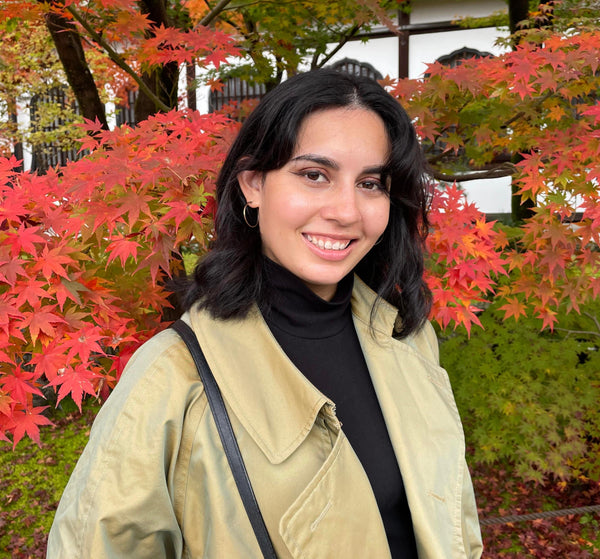
0 comments